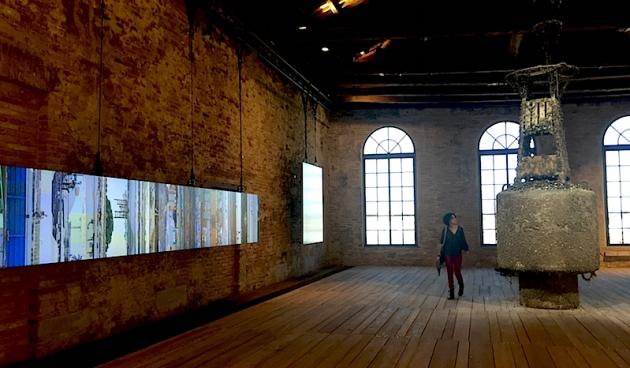After a brief hiatus in 2013, Singapore returns to Venice this year with a pavilion in the historic Arsenale, in the newly restored Sale d’Armi building,. It is an important year for the City State which is celebrating its 50 anniversary, and its the soon-to-be-opened National Gallery demonstrates its willingness to grow as a centre for artistic production and research in Asia.
Charles Lim’s installation at the Singapore pavilion rehabilitates the sea as a major component of the City State. It offers a poetic, immersive yet political body of work. Shabbir Hussain Mustafa, the pavilion curator describes the project as “a steady accumulation, a linking of poetic moments and discrepant realities, in search of a vocabulary about the sea and the demands one makes of it.” Charles Lim’s practice includes performance, drawing, photography and video. He has developed an intimate engagement with the natural world through field research and experimentation and emphasises a process-based approach.
The multi-disciplinary installation includes digital video works, marine charts, and a maritime buoy. Right in the centre of the pavilion stand a large buoy named SAJAHAT. It is named after an island that disappeared from the world’s nautical charts in 2002 due to Singapore’s land reclamation efforts.
SEA STATE questions and re-defines Singapore’s understanding of its land and sea borders. It reveals the gradual transformation of sea into man-made land. There is a subtle political stance in the work even though all official communication about the project tends to describe it as “a work with an elegant detachment that professes no environmental or political stance”.
The idea of presenting Singapore as a SEA STATE is quite paradoxical as the fast development of the city for the past few decades have been based on the negation of its “island” identity. When visiting Singapore, one can easily forget it is an island. In the 70’s the government implemented an active policy to relocate the inhabitants of the surrounding micro-islands which are part of Singapore, onto the main island, living in the Housing Estates. The local culture became diluted into the overall fast-paced race of the South East Asian State to become one of the world’s most developed countries. On the other hand the active and intense reclaiming policy has made the city state grow by more than 50 square miles, with sand brought from elsewhere in Southeast Asia. This has raised issues with Singapore’s immediate neighbour, Malaysia, in terms of borders.
Combining his knowledge of the sea and his love for making images, Charles Lim, a former Olympic sailor, initiated SEA STATE in 2005. It is an ongoing body of work in nine parts that explores Singapore’s loss of maritime resources and its physical transfiguration. The project is inspired by the World Meteorological Organization’s code for measuring sea conditions, which numbers the varying states ranging from calm, to moderate, to the phenomenal. It examines the dramatic consequences of major shifts in the world’s primary natural resource—water. SEA STATE has been exhibited at Manifesta 7 (2008), the Shanghai Biennale (2008), and most recently at the Singapore Biennale (2011). It aims at inverting perceptions of sea and land on the island of Singapore while exploring the biophysical and political psyche of the City State through the visible and invisible lenses of the sea.
Words/Photo: Virginie Syn © Artlyst 2015

